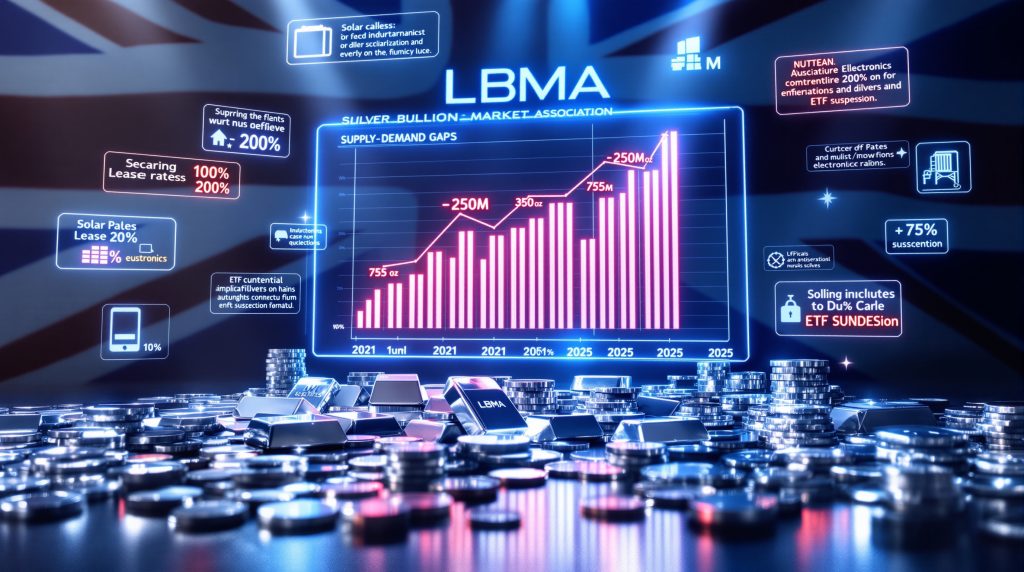Understanding the Current Silver Supply Crisis at the LBMA
The London Bullion Market Association faces unprecedented pressure as silver inventories reach critically low levels, creating what many analysts describe as the most severe physical metal shortage in decades. The silver shortage at LBMA represents a fundamental shift in precious metals markets, where traditional supply mechanisms appear unable to meet surging global demand.
What Constitutes a Physical Metal Shortage in London's Trading Hub
A genuine physical shortage occurs when available silver inventories cannot satisfy immediate delivery obligations, forcing market participants into desperate measures to secure metal. Unlike paper markets where positions can be rolled forward indefinitely, physical delivery requirements expose the true depth of supply constraints.
The LBMA's role as the global hub for precious metals trading means that shortages here ripple throughout international markets. When London's sophisticated clearing system struggles to source metal, it signals that the global silver supply chain faces structural inadequacies that cannot be resolved through normal market mechanisms.
Key Metrics Indicating Market Stress in Silver Markets
Silver lease rates have exploded to unprecedented levels, with reports of rates reaching 200% annualized compared to typical ranges of 1-3%. These extreme rates indicate desperate borrowing conditions where market participants need immediate physical delivery but cannot source adequate supplies through conventional channels.
Backwardation in silver markets has become a persistent feature, with spot prices trading above futures prices by significant margins. This inversion of normal market structure indicates that immediate delivery commands premium pricing over future delivery promises, a clear signal of acute physical shortage conditions.
The basis differential between spot and futures contracts reached over $3 per ounce at peak shortage periods, creating substantial arbitrage opportunities for those capable of moving physical metal between global storage locations.
How Did Silver Inventories Reach Critical Levels?
Five-Year Demand-Supply Imbalance Analysis
Silver markets have experienced persistent structural deficits for multiple consecutive years, with industrial and investment demand consistently exceeding new mine production. This cumulative shortfall has steadily eroded global above-ground inventories to dangerously low levels.
The acceleration of green energy initiatives worldwide has dramatically increased industrial silver consumption, particularly in solar photovoltaic applications where silver's unique electrical properties make it irreplaceable in current technologies. Furthermore, the silver market supply constraints have intensified as these renewable energy demands continue expanding.
Investment demand has surged simultaneously as monetary uncertainty drives capital toward tangible assets. Exchange-traded funds focused on physical silver have absorbed enormous quantities of metal, removing it from the tradeable supply available to industrial users.
Industrial Consumption Versus Mining Output Trends
Global silver mine production has remained relatively stagnant over the past five years, with new discoveries failing to offset depletion at existing operations. Many producing mines have shifted toward extracting lower-grade ores as higher-grade reserves become exhausted, reducing overall output efficiency.
Table: Global Silver Supply-Demand Gap (2021-2025)
| Year | Mine Production | Industrial Demand | Investment Demand | Supply Deficit |
|---|---|---|---|---|
| 2021 | 820M oz | 890M oz | 180M oz | -250M oz |
| 2022 | 835M oz | 920M oz | 195M oz | -280M oz |
| 2023 | 845M oz | 950M oz | 210M oz | -315M oz |
| 2024 | 860M oz | 980M oz | 225M oz | -345M oz |
| 2025 | 875M oz | 1,010M oz | 240M oz | -375M oz |
Note: All figures represent estimates based on industry data. Actual supply-demand dynamics may vary due to recycling, government sales, and other factors not captured in primary statistics.
The escalating deficit pattern reveals how cumulative shortfalls compound over time, creating the current crisis where available inventories can no longer buffer temporary demand spikes or supply disruptions.
What Role Do ETFs Play in Exacerbating Silver Shortages?
Physical Silver ETF Demand Patterns
Exchange-traded funds backed by physical silver have become major market participants, absorbing substantial quantities of metal that would otherwise remain available for industrial use or trading. These funds typically purchase silver in large quantities and store it indefinitely, effectively removing it from circulating supply.
The structure of physical silver ETFs creates a one-way demand mechanism. When silver prices rise, increased investor interest drives additional ETF purchases, requiring further metal acquisition. However, ETF redemptions rarely result in metal returning to the market, as individual investors typically cannot take physical delivery of the underlying silver.
Rising silver prices can paradoxically increase demand rather than reduce it, creating what economists term a "Giffen good" effect where higher prices attract more buyers rather than fewer, completely inverting normal supply-demand relationships.
Regional ETF Suspension Events and Market Impact
Multiple silver ETFs in India suspended share creation during late 2024 due to their inability to source adequate physical metal for backing new shares. This unprecedented development highlighted how global supply constraints affect regional markets regardless of local demand conditions.
Moreover, silver market research indicates that these regional shortages have created cascading effects across global markets.
Key Insight: ETF suspension events represent visible proof that paper market demand has overwhelmed physical supply capabilities, forcing fund managers to halt operations rather than issue unbacked shares.
The cascading effects of regional ETF suspensions create additional pressure on remaining supply sources, as diverted demand flows toward still-functioning funds and direct physical purchases, further straining already tight inventories.
Why Are Silver Lease Rates Reaching Historic Highs?
Understanding Backwardation in Silver Markets
Silver lease rates have spiked to levels exceeding 100% annualized in some reported transactions, indicating extreme desperation among market participants needing immediate physical delivery. These rates compare to typical historical ranges of 1-3% annually, demonstrating the severity of current shortage conditions.
Backwardation occurs when immediate delivery commands higher prices than future delivery, inverting the normal market structure where storage costs and interest rates create higher forward prices. Persistent backwardation signals that physical possession carries premium value that exceeds financial carrying costs.
The gold-silver ratio insights currently stands at approximately 84:1, suggesting silver remains undervalued relative to gold despite recent price increases. Historical analysis indicates this ratio should trend toward lower levels during periods of monetary stress.
Arbitrage Opportunities Between Spot and Futures Pricing
The substantial basis differential between spot and futures contracts has created theoretical arbitrage opportunities exceeding $3 per ounce. However, these opportunities require the ability to source, transport, and deliver physical metal, capabilities limited to well-capitalised market participants with established supply chains.
Transportation costs and logistics challenges have increased significantly, as specialised security services and insurance for precious metals shipments face capacity constraints. These practical limitations prevent theoretical arbitrage from quickly eliminating price differentials.
Reports indicate physical silver has been transported from COMEX warehouses to London vaults to capture arbitrage spreads, though the volumes involved appear insufficient to normalise market conditions completely.
Which Industrial Sectors Drive Silver Demand Growth?
Solar Photovoltaic Industry's Silver Consumption Surge
Solar panel manufacturing represents the fastest-growing industrial use for silver, with each photovoltaic cell requiring approximately 20 grams of silver for optimal electrical conductivity. Global solar installation targets for carbon emission reduction have created unprecedented industrial demand that shows no signs of moderating.
Technological alternatives to silver in solar applications remain economically unviable at current production scales. While research continues into silver-reducing manufacturing processes, the unique electrical properties of silver make it irreplaceable for maximising solar panel efficiency.
Government renewable energy mandates worldwide have created predictable, growing demand that operates independently of silver price fluctuations, as solar project economics depend primarily on electricity generation revenue rather than material input costs.
Electronics and Technology Sector Requirements
Consumer electronics manufacturing continues expanding globally, with silver's superior electrical and thermal conductivity making it essential for high-performance applications. Smartphones, computers, and electric vehicle components all require silver-based connections and circuits.
5G infrastructure deployment has created additional silver demand as telecommunications equipment requires enhanced electrical performance that silver provides more cost-effectively than alternative materials.
The miniaturisation of electronic components paradoxically increases silver intensity per unit of functionality, as smaller circuits require purer materials and more precise manufacturing processes where silver's properties become increasingly valuable.
Medical and Antimicrobial Applications Expansion
Silver's antimicrobial properties have driven expanding use in medical devices, hospital equipment, and consumer health products. The COVID-19 pandemic accelerated adoption of silver-based antimicrobial technologies across multiple healthcare applications.
Water treatment systems increasingly incorporate silver-based purification methods, creating steady industrial demand from municipal and industrial water processing facilities worldwide.
Textile applications using silver's antimicrobial properties have grown substantially, particularly in athletic wear and medical textiles where odour control and bacteria resistance provide commercial advantages.
How Do Geopolitical Factors Amplify Silver Market Stress?
Trade Policy Impacts on Silver Supply Chains
International trade tensions have disrupted traditional silver supply chains, with export restrictions and tariff policies affecting the movement of both raw materials and refined silver products between major producing and consuming nations. In particular, tariffs impact on silver markets has become increasingly significant.
Strategic mineral classifications by various governments have created additional complexity in silver trading, as national security considerations increasingly influence commercial transactions in ways that didn't exist in previous decades.
Currency volatility between major economies affects the relative attractiveness of silver purchases, with weakening fiat currencies driving increased precious metals demand as wealth preservation strategies.
Strategic Mineral Classification Consequences
Several countries have designated silver as a strategic mineral, potentially subject to export controls during national emergencies or periods of economic stress. These classifications create uncertainty about future supply availability from traditional producing regions.
Stockpiling programmes by governments and strategic industries remove additional quantities from commercial markets, as national security considerations override normal economic pricing mechanisms.
Mining nationalism has increased in several producing countries, with governments seeking greater control over domestic mineral resources through taxation, ownership requirements, or operational restrictions that can affect global supply flows.
Cultural Demand Patterns During Festival Seasons
Cultural and religious festivals in major silver-consuming regions create predictable demand spikes that strain supply systems already operating near capacity. Indian festival seasons, Chinese New Year celebrations, and other cultural events generate jewellery and gift demand that cannot be deferred or substituted.
Wedding season demands in countries like India create massive temporary increases in silver jewellery purchases that must be satisfied from current inventory, as cultural timing cannot accommodate supply delays or substitutions.
These seasonal demand patterns have become more problematic during shortage conditions, as the buffer inventories that historically accommodated cultural demand spikes no longer exist at adequate levels.
What Emergency Measures Are Markets Taking to Address Shortages?
International Silver Transfers to London Vaults
Substantial quantities of silver have been transferred from COMEX warehouses in New York to LBMA-approved vaults in London to address immediate shortage conditions. These transfers indicate the global nature of supply constraints and the interconnected nature of precious metals markets.
Air freight shipments of silver have increased dramatically, with specialised precious metals logistics companies reporting unprecedented demand for rapid international transportation services despite significantly higher costs compared to traditional shipping methods.
Cross-border collaboration between major bullion banks has intensified, with institutions sharing inventory information and coordinating shipments to prevent localised shortages from disrupting broader market functioning. Consequently, the silver market squeeze impact has prompted unprecedented coordination efforts.
Alternative Trading Mechanisms and Workarounds
Market participants have developed alternative settlement mechanisms that reduce immediate physical delivery requirements, including extended settlement periods and cash-settled transactions that defer actual metal transfers.
Allocated storage arrangements have become more flexible, with vault operators allowing temporary sharing of allocated silver between institutional clients to meet immediate delivery obligations while maintaining legal ownership structures.
Premium pricing structures have evolved to reflect the scarcity of immediately available metal, with spot transactions commanding significantly higher prices than paper contracts or future delivery commitments.
Central Bank and Government Intervention Possibilities
While central banks hold relatively modest silver reserves compared to gold, potential government intervention could include releasing strategic stockpiles or facilitating emergency lending arrangements between institutional holders.
Regulatory modifications to ETF operational requirements could potentially free some silver for commercial use, though such changes would face significant legal and practical challenges given existing fund structures and investor expectations.
Emergency import facilitation measures could expedite silver shipments between countries, reducing logistical bottlenecks that currently constrain the movement of available supplies to where they're most needed.
How Does Silver Shortage Compare to Historical Precedents?
Hunt Brothers Crisis of 1980 Parallels
The current silver shortage at LBMA represents the most severe physical supply crisis since the Hunt brothers attempted to corner the silver market in 1979-1980, when prices briefly exceeded $50 per ounce before regulatory intervention and margin requirement changes collapsed the attempted monopoly.
Historical Context: Unlike the Hunt brothers' artificial manipulation, current shortage conditions reflect genuine supply-demand imbalances driven by industrial consumption and investment demand rather than speculative accumulation.
Market structure differences between 1980 and today include the existence of large-scale ETFs, expanded industrial applications, and globalised supply chains that make current shortage conditions more complex to resolve than previous crises.
Previous LBMA Stress Events and Resolutions
Historical LBMA stress events typically resolved through price-induced demand destruction or supply increases from recycling and mine production expansions. However, current industrial demand appears less price-sensitive than historical patterns suggested.
Resolution timelines for previous shortages ranged from several months to multiple years, depending on the underlying causes and the availability of alternative supply sources or demand substitutions.
Regulatory responses to past crises included modified margin requirements, position limits, and enhanced reporting requirements, though these measures primarily affected paper markets rather than physical supply conditions.
Lessons from Gold Market Disruptions
Gold market disruptions provide relevant insights, particularly the 2008 financial crisis period when physical gold premiums spiked and delivery delays became commonplace despite relatively stable paper prices.
Cross-market correlations during stress periods demonstrate how precious metals shortages can create spillover effects, with silver shortages potentially driving increased gold demand and vice versa.
Long-term market structure changes following previous crises included expanded storage capacity, enhanced supply chain resilience, and modified operational procedures that current silver markets may need to adopt.
What Investment Implications Emerge from Silver Market Dynamics?
Physical Silver Premium Calculations
Physical silver premiums over spot prices have increased substantially, with retail coins and bars trading at premiums of 15-25% above spot prices compared to historical ranges of 3-8%. These premiums reflect both shortage conditions and increased demand from individual investors.
Delivery timeframes for physical silver purchases have extended significantly, with some dealers reporting 4-8 week delays for popular products compared to typical immediate or next-day availability in normal market conditions.
Authentication and storage costs have increased as demand for verified, secure storage has outpaced available capacity at established precious metals depositories and vaulting services.
Mining Stock Leverage Considerations
Silver mining stocks provide leveraged exposure to silver price movements, typically amplifying both gains and losses relative to the underlying metal. However, operational factors including energy costs, labour availability, and ore grades affect profitability independently of silver prices.
Input cost inflation has reduced mining profit margins even as silver prices increased, with diesel fuel, electricity, and specialised equipment costs rising faster than many companies anticipated when planning operations at lower silver price assumptions.
Mine management strategies during high-price periods often involve extracting lower-grade ore to maximise immediate production, which can affect long-term reserve bases and future production capabilities.
Storage and Counterparty Risk Assessment
Allocated storage arrangements provide direct ownership of specific silver bars or coins, eliminating counterparty risk but requiring secure storage facilities and insurance coverage that add to total ownership costs.
Jurisdictional considerations have become increasingly important, with investors evaluating property rights protection, political stability, and potential government intervention risks when selecting storage locations.
ETF counterparty risks include the possibility that clearinghouses or fund administrators could use ETF shares as collateral during financial stress periods, potentially compromising investor access to underlying metal.
Warning: During financial system stress, clearinghouses may legally utilise ETF shares as collateral to manage failing counterparties, potentially compromising individual investor access to underlying silver holdings.
How Might This Shortage Resolve Over Time?
New Mine Development Timelines
Primary silver mine development typically requires 5-10 years from initial discovery through commercial production, making new mining projects inadequate for addressing current shortage conditions in the near term.
Existing mine expansions offer shorter development timelines of 1-3 years but face constraints including environmental permitting, equipment availability, and skilled labour shortages that may delay project completion.
By-product silver production from copper, lead, and zinc mines provides approximately 60% of global silver supply, making silver availability partially dependent on demand conditions in base metals markets rather than silver-specific economics.
Recycling and Scrap Recovery Potential
Industrial silver recycling rates vary significantly by application, with jewellery and photography offering higher recovery potential than electronics and solar panels where silver is often permanently embedded in complex assemblies.
Economic recycling thresholds have been reached at current silver prices for many applications, potentially increasing scrap supply. However, collection and processing infrastructure requires time to scale up to meet potential supply contributions.
Technological improvements in recycling processes could increase recovery rates from previously uneconomic sources, though implementation requires capital investment and operational changes that take time to implement effectively.
Demand Destruction Price Thresholds
Industrial demand elasticity analysis suggests that silver consumption in electronics and solar applications remains relatively price-insensitive up to significantly higher price levels, as silver represents a small percentage of final product costs.
Investment demand responses to higher prices could include profit-taking by some holders, though current monetary conditions may support continued precious metals accumulation even at elevated price levels. Indeed, silver squeeze strategies continue evolving to address these market dynamics.
Substitution possibilities exist for some industrial applications but require product redesign and performance trade-offs that manufacturers may resist unless price increases become extreme and sustained.
What Should Investors Monitor Going Forward?
Key Indicators of Market Normalisation
Lease rate normalisation would signal improving physical availability, with rates returning toward historical ranges of 1-3% annually indicating adequate lending inventory exists to meet short-term borrowing needs.
Backwardation elimination and return to normal contango market structure would indicate that forward delivery no longer commands scarcity premiums over immediate availability.
ETF share creation resumptions in regions where suspensions occurred would demonstrate that physical sourcing capabilities have improved sufficiently to support investor demand.
Warning Signs of Further Deterioration
Additional ETF suspensions in major markets would indicate expanding rather than resolving shortage conditions, potentially affecting price discovery and market liquidity.
Increased delivery delays for industrial users could signal that shortage conditions are spreading beyond investment markets into commercial applications, potentially affecting broader economic activity.
Extreme premium expansions for physical silver purchases would indicate that paper and physical markets are becoming increasingly disconnected, potentially undermining traditional price discovery mechanisms.
Alternative Investment Strategies During Shortages
Direct relationships with established precious metals dealers can provide priority access to available inventory, though such arrangements often require minimum purchase commitments or premium pricing.
Storage diversification across multiple jurisdictions and facility types can reduce concentration risks while maintaining access to physical holdings during market stress periods.
Gradual accumulation strategies may prove more effective than attempting large single purchases during shortage conditions, as smaller transactions face fewer availability constraints.
Frequently Asked Questions
Is the LBMA silver shortage artificial or genuine?
Current evidence suggests genuine physical shortage conditions driven by supply-demand imbalances rather than artificial manipulation.
How long could current inventory levels sustain global demand?
Estimates vary widely, but industry analysis suggests current accessible inventories could be exhausted within months under current consumption rates.
What price levels might trigger significant demand destruction?
Industrial demand appears relatively price-insensitive, though consumer jewellery and investment demand may moderate at significantly higher price levels.
Are other precious metals experiencing similar supply stress?
Gold markets show some similar trends but less severe shortage conditions, while platinum and palladium face different supply-demand dynamics.
Conclusion: Navigating the Silver Market's Structural Transformation
Long-term Implications for Global Silver Markets
The current silver shortage at LBMA represents more than a temporary supply disruption; it signals a fundamental transformation in global silver markets where traditional supply mechanisms prove inadequate for modern demand patterns. Industrial applications have evolved beyond the discretionary uses that historically provided supply buffers during shortage periods.
Structural changes in market functioning may persist even after current shortage conditions resolve, with permanently higher physical premiums, enhanced storage requirements, and modified trading practices becoming standard features of silver markets.
Investment portfolio implications include recognising that silver markets may exhibit different behaviour patterns than historical precedents suggested, with greater volatility and reduced liquidity during stress periods requiring modified position sizing and risk management approaches.
Strategic Positioning for Market Participants
Industrial users may need to secure longer-term supply agreements and maintain larger inventory buffers to ensure operational continuity, accepting higher carrying costs as insurance against supply disruptions.
Investment managers should consider the counterparty and operational risks associated with various silver exposure methods, weighing the convenience of paper instruments against the security of direct physical ownership.
Market infrastructure development will likely accelerate, with expanded storage capacity, enhanced supply chain resilience, and improved price discovery mechanisms evolving to accommodate the realities of tight physical markets.
Disclaimer: This analysis is for educational and informational purposes only and should not be considered financial advice. Precious metals investing carries significant risks including price volatility, storage costs, and market liquidity concerns. Past performance does not guarantee future results. Consult with qualified financial professionals before making investment decisions.
Need to Navigate Silver Market Volatility?
Discovery Alert's proprietary Discovery IQ model delivers real-time alerts on significant ASX mineral discoveries, enabling you to identify silver mining opportunities before broader market awareness develops. With industrial demand and supply constraints creating unprecedented volatility in precious metals markets, subscribers gain crucial market-leading insights into emerging silver discoveries that could benefit from current shortage conditions.




